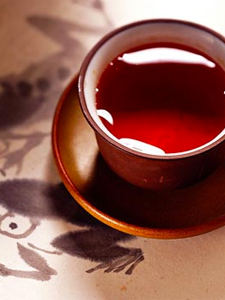RED TEA: Common Term Can Be Uncommonly Confusing

CHINA RED TEA
That is still true. Red tea in China is made from the ancestral tea bushes of Camellia sinensis, dried to a deep brown leaf and brews up to a mahogany red to shades lighter and darker in the cup depending on the province where it grows. Some of the best are Qimun, Anhuui, Fujien, and Yunnan. Chinese red teas are bold in flavor and cover a wide spectrum of tastes from tannic to smooth, earthy to sweet, woodsy to floral and fruity and some, with a chocolate edge.
One folk tale about red tea involves a scholar who, disheartened because he had lost his post, spent hours pondering the loss and what the future would bring. Finally, he remembered his father's advice to learn a handicraft in addition to his scholarly work. At first, he thought he would learn more about processing the green teas that were popularly grown and processed in his hometown. Fully aware that there were significantly better green teas than these, he was determined to learn how to make better teas, perhaps a different kind. Upon learning about the red tea from Fukien, he set out on a journey there, where farmers taught him how to grow, harvest, and process leaves for a new style of tea. This tea was fully dried, offered a beautiful red liquor in the cup, and a wonderful, complex flavor for the palate. He studied and honed this new technique and in time, brought it back to his hometown and helped spread the new processing skill to many other provinces thus insuring the longevity of red tea making and a future for himself and many of his neighbors.
RED TEA AS HERBAL
Today, there's another completely new "red tea", rooibos, the South African tisane made from Aspalathus linearis, a member of the Fabaceae family. Its reddish brown stems and dark green, needle shaped leaves are harvested, cut into small pieces, bruised and oxidized. Rooibos has as much or often more antioxidants than Camellia sinensis, but has none of the stimulants, so it is ideal for those sensitive to xanthines (caffeine, theine, theobromine.) Rooibos blends beautifully with flavors from lemongrass to vanilla and more, and is fairly inexpensive (the word rooibos comes from the Dutch word meaning red bush, referring to the bright red color of the tea in the cup).
TRUE CHINA BLACK: Dark Tea (hei cha)
So, if red tea is black tea in China is there no such thing as black tea? There is! This category of black tea in China is called hei cha or hong cha and is manufactured in Guanxi, Hunan, Sichuan, and Yunnan provinces using large and medium-sized leaves collected from high mountain areas. The oxidized tea leaves undergo the wo dui process which exposes the leaves to high humidity over a determined period of time in a controlled environment (such as in a building or factory). Some hei cha is dried over the low heat of pine wood embers. Hei cha varies in flavor from sweet and woodsy and soft to earthy but never astringent. It can be drunk young or aged for years after formed into various shapes - rectangles, squares, round discs both large and small or loose leaf, similar to the more familiar puerhs sold here. Harvesting and processing is unique to each area where hei cha grows; it is rarely exported so the opportunity to taste it here in the U.S. is rare but more and more vendors are seeking out sources.
Legend has it that hei cha developed (as many other teas have) by accident. It is posited that unoxidized green tea bricks (mao cha) carried over the long trading routes from China to Tibet and Mongolia sometimes absorbed moisture through humidity or rain and were thought unsaleable. Unwilling to toss the teas (and the profits) after such long and arduous journeys, some clever traders convinced buyers that these teas were as healthful as they were delicious. And, it has come to be revealed that they do contain probiotic bacteria from their absorption of moisture.
And, the name hei cha? That comes from the hue of the leaves: "dark tea".
